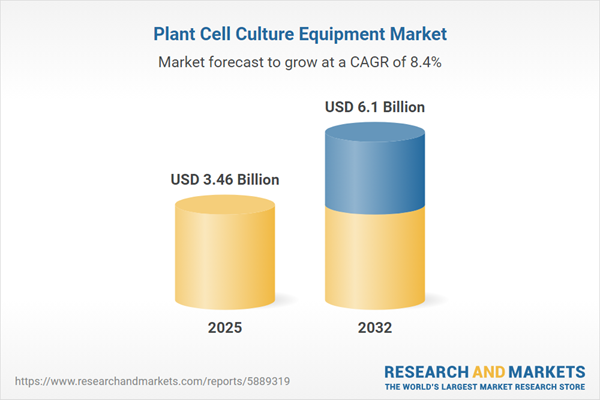Speak directly to the analyst to clarify any post sales queries you may have.
Plant cell culture equipment is shaping the future of biotechnological research, supporting innovation in pharmaceuticals, agriculture, and life sciences. For organizations prioritizing scalable, efficient, and reliable bioprocessing, understanding current market opportunities and challenges is essential for senior leadership strategy.
Market Snapshot: Plant Cell Culture Equipment Market
The Plant Cell Culture Equipment Market grew from USD 3.21 billion in 2024 to USD 3.46 billion in 2025. It is expected to continue expanding at a CAGR of 8.36%, reaching USD 6.10 billion by 2032. This trajectory highlights robust demand for advanced instrumentation as organizations pursue breakthroughs in plant-based therapeutics, crop resilience, and sustainable production processes. Global industry participants face an evolving landscape driven by emerging technology needs and shifting regulatory environments.
Scope & Segmentation
- Equipment Types: Autoclaves, culture vessels, incubators, laminar flow hoods, microscopes, refrigerators, shakers, and agitators address diverse laboratory and production requirements.
- Cell Culture Techniques: Callus culture for mass cell proliferation, hairy root culture to enable metabolite synthesis, protoplast culture for cellular manipulation, and suspension culture suitable for scale-up applications.
- Category: Reusable systems offering long-term efficiency, and single use systems that support operational flexibility and lower contamination risk.
- Application Areas: Agriculture, cosmetics, food and beverages, pharmaceuticals and biopharmaceuticals, and research and development.
- End User Groups: Academic and research institutes concentrating on precision protocols, biotech and biopharma companies with throughput needs, and contract research organizations focusing on efficient, scalable workflows.
- Geographic Regions:
- Americas: United States, Canada, Mexico, Brazil, Argentina, Chile, Colombia, Peru
- Europe, Middle East & Africa: United Kingdom, Germany, France, Russia, Italy, Spain, Netherlands, Sweden, Poland, Switzerland, United Arab Emirates, Saudi Arabia, Qatar, Turkey, Israel, South Africa, Nigeria, Egypt, Kenya
- Asia-Pacific: China, India, Japan, Australia, South Korea, Indonesia, Thailand, Malaysia, Singapore, Taiwan
- Industry Companies Analyzed: ACMAS Technologies (P) Ltd., Agilent Technologies Inc, Aralab, Cole-Parmer Instrument Company, LLC, Controlled Environments Limited, Genetix Biotech Asia Pvt. Ltd., Greiner Bio-One International GmbH, Holy Scientific, LabRepCo LLC, LGC Limited, Life Technologies (India) Pvt. Ltd., Merck KGaA, PerkinElmer Inc., PhytoTech Labs, Inc., Plant Cell Technology inc., Sheel Biotech Limited, TAIWAN HIPOINT CORPORATION, Tanco by P L Tandon & Co ., Thermo Fisher Scientific, Inc., Visser 's-Gravendeel Holding B.V., HiMedia Laboratories Ltd.
Key Takeaways: Growth Drivers and Strategic Insights
- Advanced automation, modular equipment design, and integrated digital features are enhancing workflow reproducibility and minimizing errors for plant cell culture applications.
- Transition from traditional reusable systems to single use and microfluidic solutions is reducing cross-contamination risks and offering cost efficiencies for users with high throughput requirements.
- Collaborative partnerships between equipment manufacturers and software providers are transforming laboratory operations with remote control capabilities and predictive maintenance alerts.
- Regional demand for plant cell culture equipment is influenced by investment levels in life sciences infrastructure, regulatory frameworks, and the pace of biotechnological innovation.
- Strategic supplier collaborations and vertical integration across the value chain are consolidating the market, delivering comprehensive solutions and unified technical support.
- Agile response to policy or trade developments enables sustained momentum in research, underscoring the need for diverse sourcing and resilient supply strategies.
Tariff Impact: Assessing United States Policy Effects
Recent United States tariff adjustments have introduced complexity into global supply chains. Precision incubator chambers, shakers, and disposable vessels sourced internationally now face increased cost pressures. To mitigate operational disruptions, manufacturers are diversifying production sites, collaborating with local partners, and building buffer inventories. Effective capital investment planning and adaptable supplier agreements enable organizations to address these policy fluctuations while maintaining research continuity.
Methodology & Data Sources
This report leverages a rigorous research framework combining primary interviews with laboratory and procurement professionals and secondary analysis of journals, white papers, and regulatory guidelines. Proprietary databases and subject-matter workshops ensure data triangulation, accuracy, and real-world relevance in conclusions regarding market drivers and competitive positioning.
Why This Report Matters
- Equips decision makers with actionable insights on plant cell culture equipment trends, technology adoption, and emerging business models for informed strategic planning.
- Enables organizations to benchmark against global and regional peers while identifying opportunities for automation and efficiency improvements across segmented applications.
- Facilitates proactive risk management by highlighting supply chain adaptations and regulatory shifts impacting equipment investment decisions.
Conclusion
The plant cell culture equipment market is transitioning through significant innovation and operational change. Success will depend on aligning technology investment, partnership strategies, and adaptive business models to evolving regional and sector requirements.
Additional Product Information:
- Purchase of this report includes 1 year online access with quarterly updates.
- This report can be updated on request. Please contact our Customer Experience team using the Ask a Question widget on our website.
Table of Contents
3. Executive Summary
4. Market Overview
7. Cumulative Impact of Artificial Intelligence 2025
Companies Mentioned
The companies profiled in this Plant Cell Culture Equipment market report include:- ACMAS Technologies (P) Ltd.
- Agilent Technologies Inc
- Aralab
- Cole-Parmer Instrument Company, LLC
- Controlled Environments Limited
- Genetix Biotech Asia Pvt. Ltd.
- Greiner Bio-One International GmbH
- Holy Scientific
- LabRepCo LLC
- LGC Limited
- Life Technologies (India) Pvt. Ltd.
- Merck KGaA
- PerkinElmer Inc.
- PhytoTech Labs, Inc.
- Plant Cell Technology inc.
- Sheel Biotech Limited
- TAIWAN HIPOINT CORPORATION
- Tanco by P L Tandon & Co .
- Thermo Fisher Scientific, Inc.
- Visser ’s-Gravendeel Holding B.V.
- HiMedia Laboratories Ltd.
Table Information
| Report Attribute | Details |
|---|---|
| No. of Pages | 182 |
| Published | November 2025 |
| Forecast Period | 2025 - 2032 |
| Estimated Market Value ( USD | $ 3.46 Billion |
| Forecasted Market Value ( USD | $ 6.1 Billion |
| Compound Annual Growth Rate | 8.3% |
| Regions Covered | Global |
| No. of Companies Mentioned | 22 |









